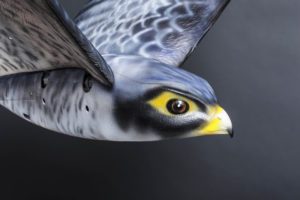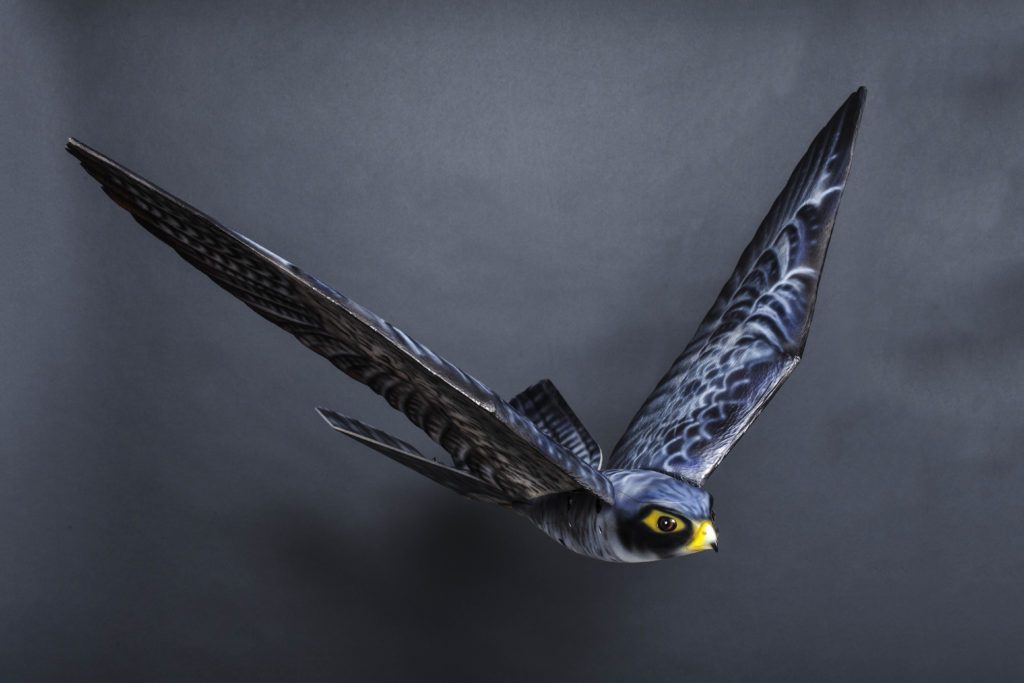
By: Dawn Zoldi
At the Edmonton International Airport and Grand Forks International Airport in North Dakota, a Peregrine falcon soars near the runway to deter birds from interfering with air traffic. It looks real. But it’s not. It’s a flying robot called the RoBird®.
Continue reading below or listen:
RoBird has wings that flap. It flies, like a falcon, for five minute high-impact stints. Also like its counterpart in nature, the RoBird can reach speeds of up to 27 miles per hour.
Aerium Analytics, a multi-disciplined drone solutions company based in Calgary, Alberta, produces this novel drone, a ornithopter, that mimics the look and actions of the predatory bird.
Data First
Since its inception in 2016, the company has specialized in geospatial intelligence, data analytics, visualization and software development for global clients across a myriad of industries.
According to Aerium CEO Jordan Cicoria, the family business, The Lorrnel Group, a professional environmental stewardship and compliance consultancy created by his mother in 1982, spun the company off to harness the power of aerial data for environmental good. Aerium originally focused on using drones in support of Lorrnel’s primary sectors: forestry, energy, mining and logistics.
Cicoria, with over 15 years experience in regulatory and environmental management explained, “It’s all about the data. Drones can collect vast sums of high quality geospatial data in a fraction of the time it would take to do it manually.”
Over time, the company grew its drone fleet. It developed artificial intelligence-powered detection and analysis software and a simplified visualization portal. This suite of tools takes the collected data and rapidly translates it into useful visual information for decision makers in highly regulated industries such as airports and mining.
Aerium’s use cases at airports include real time detection of foreign object debris (FOD), runway markings inspections and perimeter security. In the wildlife and forestry sectors, Aerium’s drones and back-end analytics support habitat risk analysis and attraction potential, high risk slope and fiber inventory analysis, road selection support and asset/infrastructure maintenance efforts. In the energy sector, the company monitors tailings ponds, engineered dam and dyke facilities that hold the by-products of mining operations extraction processes.
All of these sectors, Cicoria realized, shared a similar problem: “negative bird and human interactions.”
Wildlife Solution Hatched
In aviation, as migratory patterns change and more aircraft take to the skies, potentially deadly bird strikes continue to rise. In mining, bird landings on tailing ponds can lead to bird deaths and other negative impacts to migratory bird species. In some cases, these bird deaths can also impact company bottom lines, in the form of steep environmental regulatory fines.
Cicoria also knew that current methods of bird deterrents, such as pyrotechnics, air cannons and loud speakers had minimal effect. They also had their own second order negative environmental impacts.
In 2016, Cicoria found the perfect solution. As he described it, on a “fateful trip to Japan” as part of an Alberta Delegation to an aerospace convention, he met with Edmonton International Airport and simultaneously discovered RoBird, created by Netherlands-based Clear Flight Solutions (also known as The Drone Bird Company). He knew it would be a perfect bird-strike mitigation and wildlife management tool. He “immediately brought it to Canada.”
Three years later, Aerium purchased the worldwide rights to RoBird. It now manufactures them in Calgary Alberta Canada. Its pilots fly them manually around the world in places ranging from high visibility airports in the U.S. and Canada to blueberry farms in the Netherlands and dredging operations in Kazakhstan.
RoBird’s impacts have been profound.
Positive Impacts Soaring
Aerium’s partner airports have reported up to an 80% reduction in bird strikes year over year. Its mining clients have seen a 75% reduction in bird mortalities in the same time span.
Cicoria said, “RoBird works because the Peregrine falcon is one of the most feared aerial predators in the world. It is known on six of the seven continents. Nearly every flocking bird species has been predated on by Peregrines.” He refers to the drone as a “sheepdog in the sky.”
Aerium plans to continue building on RoBird’s success. Its vision is to have full autonomous flocks-in-a-box, with onboard detect-and-avoid and integrated wildlife detection sensors. Eventually, it seeks to bring Robird to market using a hardware-as-a-service model. Equity and grants fundraising efforts are currently underway.
“RoBird is a perfect example of the evolution of drone technology which looks at what nature does incredibly well and finds ways to replicate. The integration of drones in our daily lives will occur when they make work and life safer and benefit the world. RoBird does just that,” said Cicoria.
See the Dawn of Drones Interview: AERIUM on Dawn of Drones This Week! Integrating Drones and Traditional Aviation for the Airports of the Future
Listen to the Drone Law Connections Clubhouse Replay with Aerium’s Dan Juhlin: https://www.clubhouse.com/room/MdbgnEJ8
Miriam McNabb is the Editor-in-Chief of DRONELIFE and CEO of JobForDrones, a professional drone services marketplace, and a fascinated observer of the emerging drone industry and the regulatory environment for drones. Miriam has penned over 3,000 articles focused on the commercial drone space and is an international speaker and recognized figure in the industry. Miriam has a degree from the University of Chicago and over 20 years of experience in high tech sales and marketing for new technologies.
For drone industry consulting or writing, Email Miriam.
TWITTER:@spaldingbarker
Subscribe to DroneLife here.

